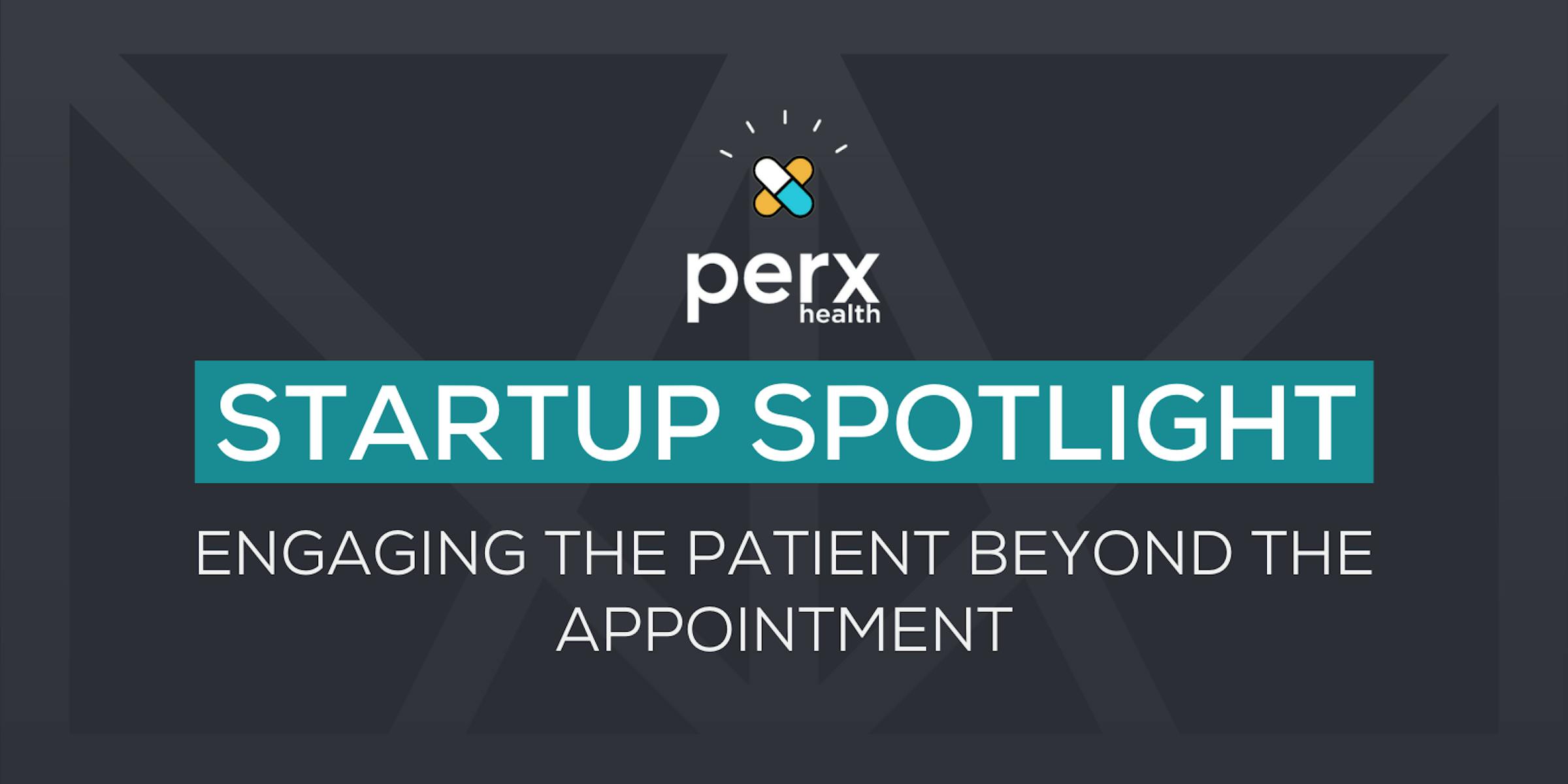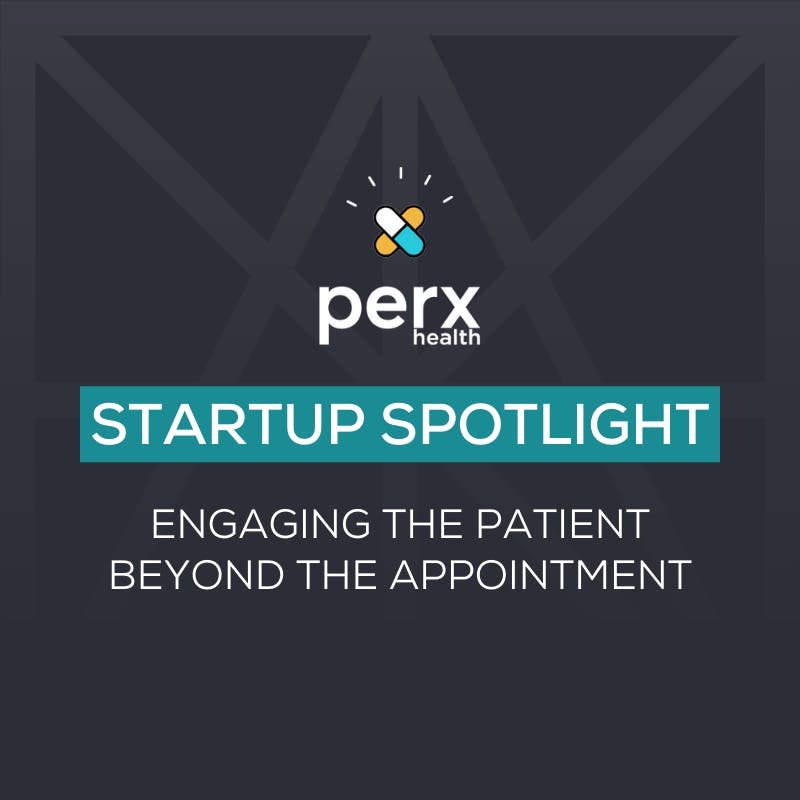MATTER Startup Spotlight: Perx Health
Leveraging digital health to engage the patient beyond the appointment
According to U.S. Pharmacist, treatment adherence rates of 80 percent or higher are needed for optimal therapeutic efficacy. However, it’s estimated that adherence to chronic medications is only about 50 percent. MATTER member Scott Taylor, CEO and co-founder of Perx Health, is aiming to leverage digital health to improve treatment adherence.
In 2016, Scott and his co-founder, Hugo Rourke, left successful careers in finance and consulting to start a healthcare startup on a mission to pioneer a motivational health community for everyone. Since then, Perx has expanded from their initial launch in Australia to the U.S. and partnered with over 15 health plans and health customers, and their behavioral science approach to patient engagement has become the market leader.
Read on for Perx’s journey over the last six years, how they’re changing healthcare and CEO Scott Taylor’s advice for entrepreneurs just starting out.
Responses have been edited for length and clarity.
MATTER: Give us the story behind Perx Health. Why did you and your co-founder, Hugo, leave other industries to start a healthcare company?
Scott: “Like most people, we both have family members who are managing chronic conditions. The reality is that up to 50 percent of people are managing a chronic condition, and up to a third of people are managing one or more chronic conditions. So that doesn’t make our situation particularly unique, but one aspect that does is that Hugo and I have both advised, invested in and worked with high engagement industries that have no issue driving engagement and behavior change, such as consumer technology and retail. And many of those people managing chronic conditions struggle to make long-term behavior change stick.
“We noticed that our family members were struggling to stick to simple treatment plans, whether it was taking medication, completing physical therapy or logging clinical measurements. When we looked at the ways healthcare drove adherence to treatment plans, we saw it mainly relied on only education or information — handing out flyers on the way out of the doctor’s office or coaches sharing information with a patient — and expecting that to change their behavior long term. Yet many other industries have already determined that education is one of the least effective ways to drive behavior change.
“We thought, ‘Can we take some of the strategies that other industries know drive engagement and behavior change and bring them to healthcare?’ We realized that if this idea worked — and even if we weren’t the ones who executed it — hundreds of thousands of people could benefit. And with people diagnosed with a chronic condition every minute of every day, we knew we needed to launch the company and start making a difference. That was the impetus for us taking the leap and starting Perx.”
MATTER: You wrote an article on Medium, “Why telehealth must Zoom beyond video to fulfil its potential.” How can we solve the challenge of engaging patients beyond the appointment?
Scott: “First of all, when we think of telehealth, we typically imagine a video call between a clinician and a patient — which has been fantastic in improving access to care, particularly during the last two years with COVID-19. But what’s happening with telehealth, and digital health more broadly, is we’re taking the same model of care that we’ve used in traditional healthcare for centuries and simply translating it to digital. We haven’t actually adapted to the technology or capitalized on the benefits that digital can bring.
“We need to take a clean-slate approach to build the future model of healthcare, which should be built with the presumption that we can engage people digitally. And if we change the channel through which we’re engaging with patients, then we should also reconsider the cadence of appointments. Why would we continue with 20-minute appointments every six months when we can leverage technology to engage with patients multiple times a day in a way they enjoy, encouraging them to complete clinical tasks, such as taking medication, completing physical therapy or logging clinical measurements?
“We believe the model of care should start to look different based on the presumption that digital is the way forward for healthcare.”
“We believe the model of care should start to look different based on the presumption that digital is the way forward for healthcare.”
MATTER: Tell me a little bit more about Perx Health and the solution you provide.
Scott: “We know that the number one challenge for health plans and healthcare systems in delivering digital care to high-risk patients is engagement. Far too many patients simply don’t enroll in digital programs or don’t engage frequently enough or long enough to actually see results. Perx is solving that problem, entirely digitally.
“We have built the world’s highest engagement platform for people living with high-risk chronic conditions. Patients engage with our digital programs four to five times daily and consistently for over 6 months. And when we roll out programs we see over 50 percent of patients enroll. We achieve this by using consumer strategies, behavioral science and predictive analytics to find the best ways to engage different patients.
“We use a combination of extrinsic and intrinsic motivators such as rewards, gamification, community and accountability to engage patients in our patient-facing app multiple times a day and keep them engaged for longer. This helps our clients, internal care teams and case managers get a much richer set of data on how their patients are managing themselves.
“Beyond delivering our own programs, we can deliver an engagement layer for those high-risk patients who need to manage their healthcare at specific times of the day. We can embed our technology in existing digital health stacks of health plans, healthcare systems, employers and even other digital health solutions to drive better engagement with their existing programs, as well as provide programs for patients where there might not be a program already.”
MATTER: What results have you seen thus far?
Scott: “We’ve run programs for over 20,000 Perx members and across about 15 health plans and health systems in Australia and the U.S. We see that when patients use Perx, they achieve over 95 percent adherence to their treatment plans.”
“In a randomized control trial conducted by the University of Sydney and published in the BMJ, we found that people with complex diabetes and cardiovascular conditions were twice as adherent to their treatment plan and saw significant improvement in underlying biomarkers when using Perx over an observation period of 12 months versus the control group.
“Also, when health plans, health systems and payers invest in Perx for their high-risk members, they see not only improved engagement, adherence and underlying health biomarkers but also improved cost outcomes. In working with a large global insurer, they saw over $6,000 in annual savings for the people who used Perx versus those who did not. As fantastic as the cost savings are, we’re driving patients to adhere to their treatment plans, and they’re achieving better health outcomes as a result.”
“As fantastic as the cost savings are, we’re driving patients to adhere to their treatment plans, and they’re achieving better health outcomes as a result.”
MATTER: What makes Perx different from other engagement platforms?
Scott: “A lot of solutions describe themselves as ‘engagement platforms’ but struggle to deliver actual engagement. What sets Perx apart is our enrollment, engagement and retention of members relative to industry benchmarks. We are generally able to enroll over 50 percent of a target population in Perx programs, and there are very few digital health platforms that can consistently engage patients four to five times a day for over six months.
“The typical digital health app engages patients for five and a half days; the average Perx member uses our app for 189 days. Simlarly, over 70 percent of Perx Members are active every day, whereas for other leading health apps, this metric tends to be between 10 to 15 percent.
“The typical digital health app engages patients for five and a half days; the average Perx member uses our app for 189 days.”
“According to the Centers for Disease Control and Prevention, 40 percent of Americans are managing two or more different chronic conditions. We need a solution they can use to manage their entire health and wellbeing, not single, siloed solutions for each condition they have. Perx is configurable to any conditional comorbidity because our approach is rooted in behavioral science and consumer engagement without relying on content on a specific condition. This enables us to not only deliver a diabetes program, behavioral health program or a musculoskeletal program but a program for the high-risk patient managing all three of those conditions using a single solution.
“The final difference that is very important and that I’m particularly passionate about is our ability to drive outcomes for patients with complex social determinants of health (SDoH). One of the challenges of education-based solutions is that they rely on the patient to have a high level of health literacy. By requiring high health literacy to effectively complete a treatment plan, we are shutting out people with low health literacy, and I don’t think that’s the right approach.
“By requiring high health literacy to effectively complete a treatment plan, we are shutting out people with low health literacy, and I don’t think that’s the right approach.”
“People affected by complex SDoH are higher-risk and higher-cost, and unfortunately, they’ve been left behind by many of the first digital health solutions. However, because Perx takes a behavioral consumer approach to driving engagement and improvement in health, we are very effective at engaging people with complex social determinants of health.
“We are quite passionate about making sure that Perx is accessible to everyone, not just to those who have an employer-sponsored, private health insurance package.”
MATTER: Do you have any advice for other entrepreneurs?
Scott: “My advice for other entrepreneurs is to embed yourself in the problem from the start. The more conversations you have, the closer you will get to the root cause of the problem. However, as much as people are willing to offer an opinion on why they think the problem exists or how they think the problem should be solved, you’re probably going to get a lot of conflicting opinions.
“When we spoke with pharmacists, clinicians and patients about why people struggle to engage with their treatment plans, we heard:
‘It’s the older demographic who really struggle with this because they are struggling to remember to take medications.’
‘It’s all the busy, middle-aged people who are busy with work and kids and don’t have time to stick to their treatment plan.’
‘Oh, it’s actually the younger generation because they think they’re invincible and don’t have to follow a treatment plan.’
“It’s important to broaden your research and seek as many opinions as possible.
“Once you’ve gathered that information, you need to decide how to test it. Create a framework with a scientific method approach to prove out and validate your assumptions. Then, build out your business strategy by determining if you can develop the technology that is needed to deliver the solution to this problem and if you can find actual people who would use it. Also consider if you can get health plans and health systems to pay for it. Think through how to scale up those programs so they are commercially viable and can deliver the outcomes needed to sustain your business over time.
“Taking that approach of seeking a myriad of opinions, testing, learning and validating your assumptions will set you up for success.”
MATTER: What obstacles or challenges have you faced as an entrepreneur, and how did you overcome them?
Scott: “One challenge is that digital health is a busy space, and there are a lot of different people doing different things. As a result, there are a lot of buzzwords that have been co-opted, so we had to tailor our pitch to overcome preconceptions people may have had based on previous discussions. For example, a company that one may think is a patient engagement program, isn’t actually engaging patients; they just call themselves that because they know engagement is an issue.
“We had to break down preconceptions around our solution by considering what engaging with a patient looks like and what questions health plans and health systems need to ask of providers — who they think are providing a similar solution to Perx. We had to compellingly explain how we’re different and why differentiation is important, and we needed to provide strong data to back that up.
“Lastly, in many ways, we had to be willing to put our money where our mouth is. Because we said we were going to deliver engagement, adherence and retention for a client, we built a pricing structure that aligned our incentives with the buyers’ in order to convince them we could deliver the results we were promising. Although it wasn’t easy, it went a long way to show that our offering was unique and that we backed the product we were delivering.”
“We built a pricing structure that aligned our incentives with the buyers’ in order to convince them we could deliver the results we were promising…. It went a long way to show that our offering was unique and that we backed the product we were delivering.”
MATTER: What value has MATTER brought to Perx Health?
“Aside from being a fantastic place to work when I first arrived in Chicago from Sydney, the community has been awesome. The events that MATTER has run have been invaluable. We participated in a startup showcase at the end of last year, and as a result, we literally had over a hundred discussions with people from health systems, health plans and others in the space who wanted to help.
“We participated in a startup showcase at the end of last year, and as a result, we literally had over a hundred discussions with people from health systems, health plans and others in the space who wanted to help.”
“As an international startup coming into the U.S., it has been crucial for us to have a network at the ready. This week, I’m actually catching up with Brian Kastenholz, Senior Director of Strategic Partnerships at Teladoc, who we connected with following that event last year. We wouldn’t have had access to someone like him that early on in our journey in the U.S. if it weren’t for MATTER. So it’s been incredibly helpful to leverage the MATTER network to build connections for the business.”
MATTER: What’s next for Perx?
Scott: “We officially launched in the U.S. at the end of last year, and we now have five people on our U.S. team, which is super exciting. I’ve moved to the U.S. as well to lead our U.S. growth strategy. We’re currently in a number of conversations with health plans and health systems about launching our next set of U.S. programs.
“We have an existing U.S. customer, a large health system in Texas, and we’re looking to continue to grow and expand with U.S. clients to reach the hundreds of thousands, if not millions, of U.S. patients managing complex chronic diseases, helping them improve their health and ultimately helping health plans and payers improve cost outcomes.”
About Perx Health
Perx Health is building the world’s leading daily engagement platform for high-risk, polychronic and complex SDOH patients — the most expensive patients in healthcare.
Poor patient engagement and adherence are the number one challenges for health payers and providers in delivering digital care to their highest-risk patients. The typical digital health solution engages patients for only 5.5 days.
Perx Health’s proprietary precision behavior change approach motivates high-risk patients to engage 4-5 times daily and consistently for an average of 189 days. In doing so, Perx helps patients sustain 95% adherence to critical clinical tasks and form long-term habits for self-management. These results are achieved regardless of patients’ complex co-morbidities, level of health literacy or socioeconomic status.
In just three years we have partnered with over a dozen major payer, provider and pharmaceutical customers in Asia-Pacific and the U.S., supporting over 20,000 people living with 25 different chronic conditions. We’re building a product suite that enables any healthcare organization to create daily, habitual engagement with their highest-need patients. We’d love to connect with more of these organizations.
About MATTER
MATTER, the premier healthcare incubator and innovation hub, includes more than 300 cutting-edge startups from around the world, working together with dozens of hospitals and health systems, universities and industry-leading companies to build the future of healthcare. Together, the MATTER community is accelerating innovation, advancing care and improving lives. For more information, visit matter.health and follow @MATTERhealth.




